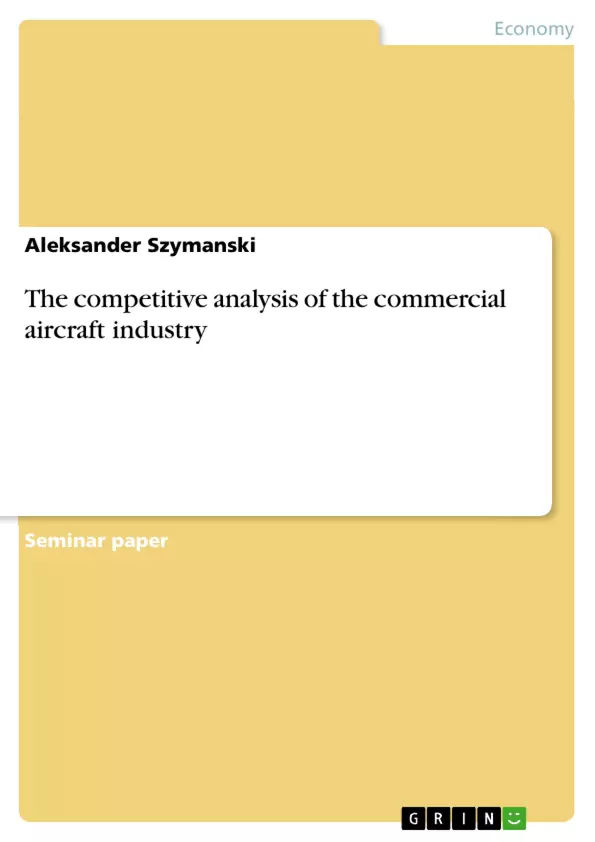The purpose of this paper is to analyze the competitive situation of the Boeing Company in the aerospace sector. The first part provides detailed information about the whole business sector with the intention to establish a foundation for an understanding of the complex and unique nature of this branche. Only having a comprehensive overview over the whole sector, one is able to identify the industry attractiveness properly, including the trends and driving forces. The second part provides a concise evaluation of the competitiveness of North America (Boeing’s main production place) based on a theoretical framework. The third part is concerned with the Boeing Company itself and contains a brief company description and a broader competitiveness analysis of the firm. Furthermore, the author will attempt to identify the core competencies of Boeing and to point out potential business opportunities. Finally, in the last part, one can find particular strategic recommendations based on the factual data with respect to Boeing and its business environment and the theoretical analysis.
Table of Contents
- 1. THE INTRODUCTION
- 2. THE ENVIRONMENT – THE AEROSPACE INDUSTRY
- 2.1 The data
- 2.2 The theoretical application
- 2.3 The characteristics of the aerospace industry in the U.S.A – Boeing's major production place
- 3. THE COMPANY
- 3.1 Overview
- 3.2 Financial analysis
- 3.3 SWOT
- 4. KEY STRATEGIC ISSUE & STRATEGIC RECOMMENDATIONS
- 5. THE CONCLUSION
Objectives and Key Themes
This paper analyzes the competitive situation of the Boeing Company within the aerospace sector. It aims to understand the industry's complexities, its attractiveness, and the driving forces behind it. The paper utilizes a theoretical framework to evaluate the competitiveness of North America (Boeing's main production place) and examines the company's own competitive position, identifying its core competencies and potential opportunities. Key themes explored in the text include:- The competitive landscape of the commercial aircraft industry
- The influence of technological innovations and globalization on the aerospace industry
- The impact of economic downturns and global events on the industry
- The rivalry between Boeing and Airbus, as well as the market share of each company
- The role of economies of scale and market demand in shaping the industry
Chapter Summaries
Chapter 1: THE INTRODUCTION
This chapter introduces the paper's objective: to analyze the competitive situation of Boeing within the aerospace sector. It highlights the importance of understanding the industry's complexities and identifying its attractiveness and driving forces. The chapter outlines the paper's structure, providing a roadmap for the reader.Chapter 2: THE ENVIRONMENT – THE AEROSPACE INDUSTRY
This chapter delves into the environment of the aerospace industry. It begins by providing data on the industry's historical development, key players, and current market dynamics. It also discusses the theoretical framework used to analyze the industry's competitive environment, including the Five Forces Model, which assesses the threat of new entrants, bargaining power of suppliers and buyers, threat of substitute products, and intensity of rivalry among competitors. Finally, the chapter focuses on the characteristics of the aerospace industry in the U.S., Boeing's primary production location, considering factors like factor conditions and related industries.Chapter 3: THE COMPANY
This chapter focuses on the Boeing Company itself. It provides an overview of the company, including its history, current operations, and financial performance. It then undertakes a SWOT analysis, examining the company's strengths, weaknesses, opportunities, and threats. This analysis helps to identify Boeing's core competencies and potential business opportunities.Chapter 4: KEY STRATEGIC ISSUE & STRATEGIC RECOMMENDATIONS
This chapter focuses on the key strategic issues facing Boeing and provides strategic recommendations based on the analysis of the company's situation and the industry's environment. It highlights the challenges and opportunities faced by Boeing in a highly competitive market.Keywords
This paper centers on the competitive analysis of the commercial aircraft industry, focusing on Boeing's position within this dynamic market. Key terms and concepts include: aerospace industry, commercial aircraft, Boeing, Airbus, competition, market share, economic downturn, globalization, technological innovation, Five Forces Model, SWOT analysis, core competencies, strategic recommendations. The paper examines the industry's historical development, current trends, and future potential, while analyzing Boeing's strengths and weaknesses to identify potential opportunities for the company in the competitive landscape.- Quote paper
- Dr. Aleksander Szymanski (Author), 2002, The competitive analysis of the commercial aircraft industry, Munich, GRIN Verlag, https://www.grin.com/document/168683



